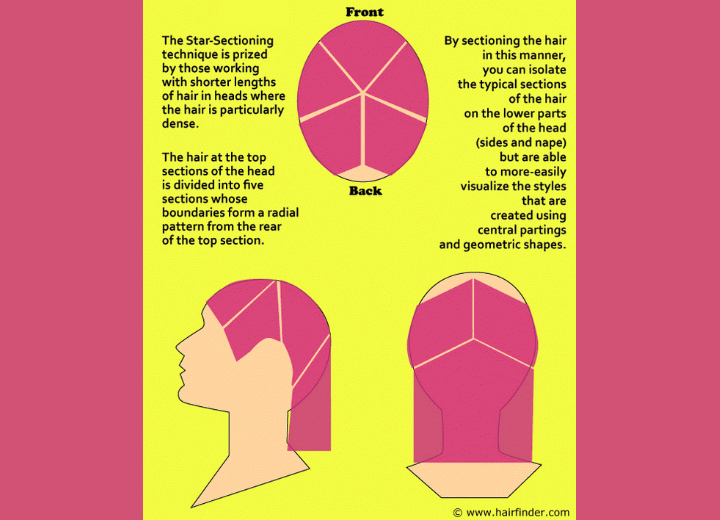Star Sectioning

When most of us think of sectioning the hair for a haircut, we think of the standard seven-section parting set-up that was learned in beauty school. This technique has been widely used for generations and is quite effective. However, innovative stylists have introduced new techniques at different points in history, including the star-sectioning technique.
The star-sectioning technique was initially utilized in a highlighting method known as peekaboo highlighting. In the "peekaboo" technique, the hair is divided into sections and pulled towards the center of the head. These inner sections are smaller in size and are lifted, allowing for coloring of the hair underneath and creating highlights that become visible when the upper layers are in motion.
When utilizing star sectioning for haircutting, there is no need to separate the star sections. The radial division of the hair provides improved control and easier manipulation since there are no sections located above or below the ones you are working with, as commonly seen in the standard parting method. Additionally, there are several other benefits:
• Enhanced control and manipulation of thicker or coarser hair types by maintaining a vertical work area.
• Better manipulation of the hair for long-layered styles and cuts that involve a stationary guide elevated above the head.
• The ability to perform different texturizing techniques more easily. Such as point cutting the ends of the hair held at a 180-degree elevation, creating evenly-distributed texture throughout the long layers.
How to create the Sections
To create a star sectioning, carefully comb or brush (for cutting, dampen) the hair to ensure it lies flat and is evenly spread around the head. Choose a point on the head, approximately one inch forward from the crown area, to begin the top section.
Using your comb, draw the end of the comb forward from the central point towards the forward corner on either the right or left side of the face. Repeat this process to create the opposite part for this forward section. Gather the hair and twist it into a secure twist, then clip it firmly in place.
Next, draw the end of your comb from the central point to the middle of the top of the ear. With smaller heads you can adjust this point to be directly behind the ear. Gather the hair on this forward-side section, twist it, and secure it with a clip. Repeat this step on the opposite side of the head, creating left and right forward-side sections.
In the back of the head, use the end of your comb to draw a line down the center of the crown section to the top of the nape area. Continue at a 135-degree angle to your initial line and draw the section boundary to the outer perimeter. This should form a diamond-shaped section. Repeat these steps on the opposite side to form a similar diamond shape. Allow the remaining hair to hang loosely.
The star sectioning has been used for virtually every haircut and style, and is especially useful in creating the stacked bob, as well as various short, shag styles. As noted above, the star sectioning technique is especially useful when dealing with very dense, coarse-textured, or generally unruly hair.
©Hairfinder.com
See also: How to section hair for coloring